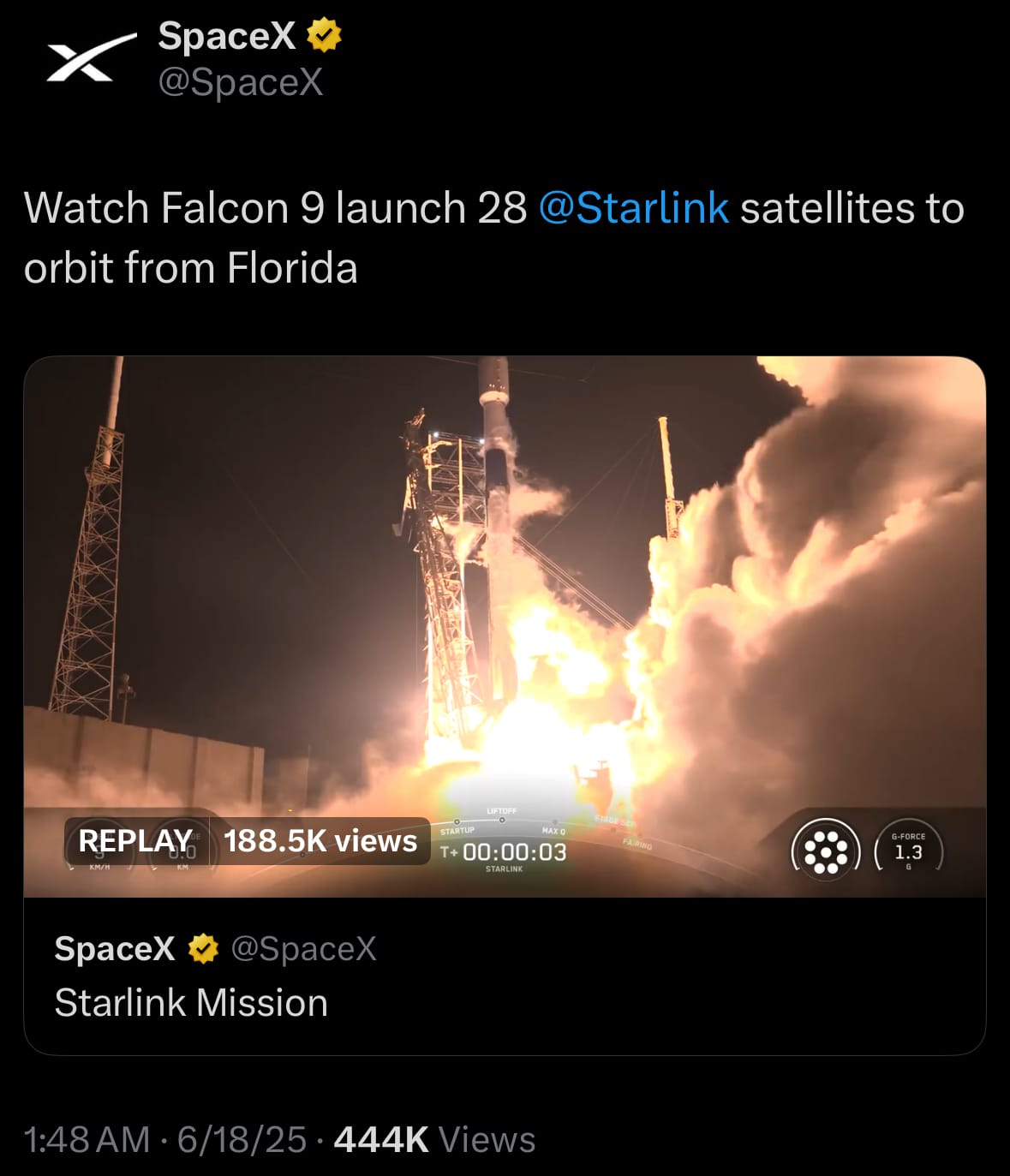Thursday☕️

Economics & Markets:
- Yesterday’s U.S. stock market:

- Today’s commodity market:

- Today’s crypto market:

Geopolitics & Military Activity:
- Yesterday, June 18, 2025, Iran implemented a nationwide internet shutdown lasting over 12 hours, reducing connectivity to 3% of normal levels, according to NetBlocks. Authorities attributed the action to Israel’s alleged use of the network for military purposes, amid rising tensions between the two countries. A graph from NetBlocks showed a significant drop in network activity, limiting residents’ access to information during a critical time. This shutdown is part of the ongoing conflict, where both nations have employed various measures, including digital controls, in their strategic rivalry.

- The internet restriction follows a series of reciprocal airstrikes between Iran and Israel. This cycle of aggression highlights the ongoing tensions, with both countries using both traditional military actions and unconventional tactics. The situation continues to evolve, with global attention focused on potential further developments.
Environment & Weather:
- As of Today, June 19, 2025, Hurricane Erick has strengthened into a Category 4 hurricane, presenting significant risks as its core approaches land, specifically the southern Mexican Pacific coast. The storm is currently moving northwestward, with its latest reported position around 16.33N 97.92W, and landfall is expected near areas such as Acapulco, potentially heading toward San Jose Estancia Grande, though its trajectory includes leftward wobbles that may alter its path. The National Hurricane Center (NHC) warns of strong winds, potential flooding, and mudslides, especially in regions with steep terrain, with heavy rain forecast for Central America and the southwest United States. Residents in the affected area are advised to take immediate steps to safeguard lives and property, as hazardous conditions are already present, and to monitor hurricanes.gov for the most current trajectory and safety updates, given the storm's dynamic nature.

- The hurricane is projected to generate a storm surge and large waves along coastal areas and the eastern coast, which may lead to additional hazards and widespread impacts through the week. The NHC's special advisory, issued at 12:00 AM CST, underscores the urgency of the situation, noting that the storm's powerful conditions are already affecting the warning area. Given the potential for rapid changes, staying informed through real-time updates on hurricanes.gov is critical for residents to prepare effectively and respond to any adjustments in the storm's path or intensity.
Space:
- Yesterday, June 18, 2025, SpaceX launched a Falcon 9 rocket from Cape Canaveral Space Force Station in Florida at 1:55 a.m. EDT, successfully deploying 28 Starlink satellites into low Earth orbit as part of the Starlink 10-18 mission. This launch, the 75th Falcon 9 mission of 2025, marked the deployment of the 9,000th Starlink satellite, advancing SpaceX’s mission to provide global high-speed internet. The V2 satellites are designed to enhance network capacity and performance. The rocket’s first stage, on its fifth flight, landed successfully on a droneship, showcasing SpaceX’s reusable rocket technology.

- Today, an explosion occurred during a static fire test of Starship Ship 36 at SpaceX’s Massey test site in Texas. The incident took place during a six-engine test, a key step for the planned Starship Flight 10. The explosion, has delayed the flight, with SpaceX now evaluating new launch windows. This setback highlights the complexities of developing Starship for deep-space missions, in contrast to the consistent achievements of the Falcon 9 program, including the successful deployment of the V2 satellites.

- Yesterday, June 18, 2025, Russia’s Roscosmos space agency launched an Angara-A5 rocket from the Plesetsk Cosmodrome in the Arkhangelsk Region. The rocket successfully deployed multiple military satellites, including one designated Kosmos-2589, into orbit. This mission, confirmed by Russia’s Ministry of Defense, marked the first operational payload delivery for the Angara-A5, a heavy-lift rocket intended to replace older Soviet-era launch vehicles.
- Details about the satellites’ specific functions were not disclosed, consistent with the classified nature of military missions. This launch highlights Russia’s efforts to advance its space program and maintain independent launch capabilities.
Statistic:
- Largest public automakers by market capitalization:
- 🇺🇸 Tesla: $1.037T
- 🇯🇵 Toyota: $230.28B
- 🇨🇳 Xiaomi: $177.62B
- 🇨🇳 BYD: $144.54B
- 🇮🇹 Ferrari: $82.76B
- 🇩🇪 Mercedes-Benz: $53.77B
- 🇩🇪 BMW: $51.39B
- 🇩🇪 Volkswagen: $51.09B
- 🇮🇳 Maruti Suzuki India: $46.61B
- 🇺🇸 General Motors: $46.23B
- 🇩🇪 Porsche: $42.97B
- 🇮🇳 Mahindra & Mahindra: $42.80B
- 🇺🇸 Ford: $41.47B
- 🇯🇵 Honda: $41.33B
- 🇰🇷 Hyundai: $38.31B
- 🇨🇳 Seres Group: $29.81B
- 🇮🇳 Tata Motors: $28.54B
- 🇰🇷 Kia: $28.16B
- 🇳🇱 Stellantis: $28.02B
- 🇨🇳 Li Auto: $26.87B
- 🇨🇳 SAIC Motor: $25.11B
- 🇯🇵 Suzuki Motor: $22.94B
- 🇨🇳 Great Wall Motors: $21.87B
- 🇨🇳 Geely: $20.32B
- 🇨🇳 XPeng: $17.88B
History:
- The U.S. has a complex history of engaging with and seeking to influence Iranian governments, driven by strategic interests in the Middle East, particularly regarding oil, regional influence, and countering perceived threats. In 1953, the U.S., alongside the UK, orchestrated a coup to overthrow Iran's democratically elected Prime Minister Mohammad Mossadegh, who had nationalized the oil industry, threatening Western interests. The CIA-backed Operation Ajax reinstated the Shah, Mohammad Reza Pahlavi, whose pro-Western, authoritarian rule aligned with U.S. Cold War objectives to counter Soviet influence. The Shah’s regime, supported by U.S. military and economic aid, modernized Iran but alienated many Iranians through repression, setting the stage for widespread discontent. This intervention established a pattern of U.S. efforts to shape Iran’s government, prioritizing geopolitical goals over Iranian sovereignty, and sowed deep mistrust that persists today.
- The 1979 Islamic Revolution, which ousted the Shah and established the Islamic Republic under Ayatollah Khomeini, marked a sharp pivot, as Iran’s new government became vehemently anti-American, culminating in the U.S. Embassy hostage crisis. The U.S. responded with diplomatic isolation, sanctions, and covert support for Iran’s adversaries, notably Iraq during the Iran-Iraq War (1980-1988), aiming to weaken the revolutionary regime. Throughout the 1980s and 1990s, the U.S. pursued policies to destabilize or replace Iran’s government, including funding opposition groups and, in the 2000s, labeling Iran part of the “Axis of Evil.” While the 2015 JCPOA briefly raised hopes of détente, the U.S. withdrawal in 2018 and subsequent “maximum pressure” campaign under Trump sought to cripple Iran’s economy, with some U.S. officials openly advocating regime change. By 2025, U.S. efforts have not succeeded in replacing Iran’s government but have fueled cycles of hostility, with sanctions and covert actions continuing to target the Islamic Republic, while Iran’s leadership remains resilient, leveraging anti-American sentiment to consolidate power.
Image of the day:

Thanks for reading!
Earth is complicated, we make it simple.
Click image to view the Earth Intelligence System:



Support/Suggestions Email:
earthintelligence@earthintel.news




